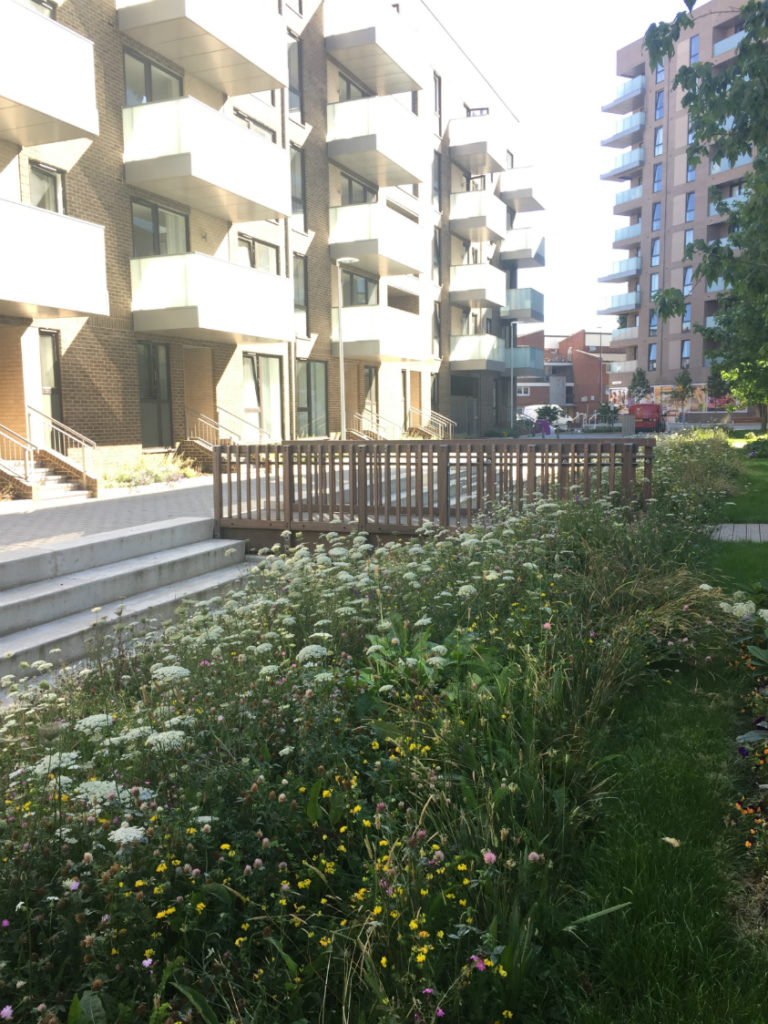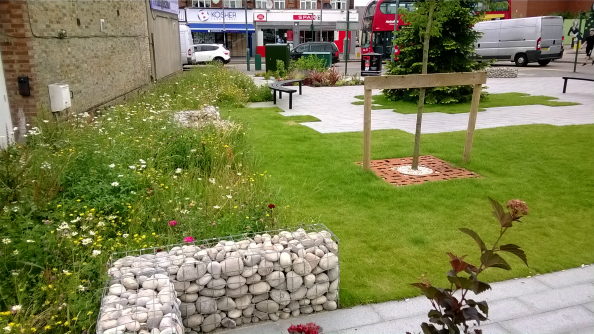Urban Wildflowers
Our MD James Hewetson-Brown explains the power of wildflowers when used in urban environments and their importance in green infrastructure design.
Quote – “WILDFLOWERS CAN PHYSICALLY LOCK IN HARMFUL PARTICULATES FROM EXHAUST EMISSIONS”
Wildflower meadows have continued to rise in popularity as more and more people become aware of the state of nature in the UK and the effect habitat loss is having on our wildlife.
There are few better opportunities for introducing a brand new wildflower meadow than in an urban environment.
For a wildflower space to really work it has to benefit people as well as wildlife. And any benefit must earn its keep. Providing pollen and nectar for bees and butterflies in an urban setting is highly laudable, but wildflowers offer many more opportunities than insect food alone. So in no particular order, here are some reasons for a landscape architect to include wildflowers in a design.

- Aberfeldy Village, East London – Levitt Bernstein Landscape Architects. Use wildflowers for SUDS as they are tolerant of pollution and keep maintenance costs down.
Pollution Mitigation
Recent work in the US and more locally at Portsmouth University, has demonstrated the benefit wildflowers can bring to limiting the effect that vehicle pollution has on people’s health. The morphology (plant structure) of a number of wildflower species has shown to physically lock up some of the really harmful PM2.5 particulates. By establishing wildflowers on the verge of a road, they forma physical barrier or net as close to the source of the pollution as is possible. This will form the first line of defence in what has become a serious health hazard.

2.Town centre garden, Shenley Road, Borehamwood – Hertsmere Borough Council.
Water Management
SUDS or Sustainable Drainage Systems is a way of managing the effects of heavy rainfall and the potential for flooding. It has become critical that plans to dissipate and filter water are built in to any new development. This water can be contaminated due to oil and chemicals lifted by heavy rainfall. Drainage ditches must be constructed of free draining material to be able to cope with heavy rainfall events. Therefore if it doesn’t rain, these ditches can become very dry. Plants that can cope with all of the above are limited, but wildflowers, once properly established, are remarkably tolerant and can deal with drought, pollution and erosion better than most. In fact they often thrive in harsh conditions.
Biodiversity
Last but by no means least, enhancing biodiversity is a requirement for most developments. Including a species rich habitat in the plans will give a boost to nature. The greater the number of plant species in a given area, the greater the opportunity for wildlife. Avoid monocultures where possible, as a variety of plants offers different food sources and leads to insect diversity. In turn this provides food for other wildlife from newts to field voles and expect to see predators from slow worms to birds of prey. Green Infrastructure can sustain food chains. Species diversity in GI will help make that chain long, varied and more resilient.
In Summary
There are potential pitfalls with wildflowers, and one of the big ones is the inclusion of too many varieties of, and too much grass. There are myths too – the need to remove soil and zero fertiliser are among these. An understanding of what is practical and what is achievable is essential. Confidence at the specification stage is as important as risk free establishment and we at Wildflower Turf Ltd do our best to help landscape professionals with these.
But get wildflowers right and they are truly a solution that keeps on giving!